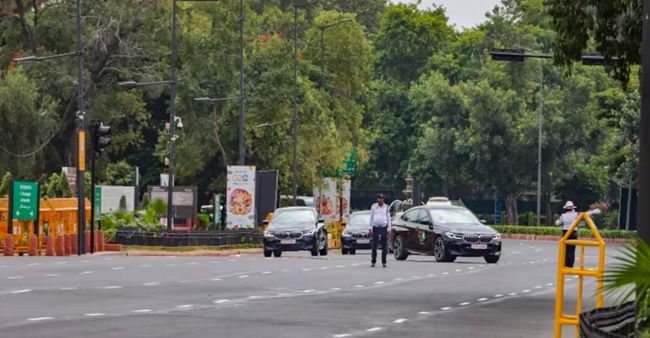‘You just wait six months and Delhi will be same old self in a year’s time’.
NEW DELHI
Delhi is dazzling. Whether it dazzled with the same amount of extravaganza right from colours to banners to “swachhata”, during the Asiad or even the Commonwealth Games most would not remember.
That is exactly why Mayor Shelly Oberoi cannot forego the chance as the city under the Lieutenant Governor Vinai Kumar Saxena’s leadership has been on a mission mode to keep civic body workers put in their every ounce of labour to help recreate the Bharat story at every nook and corner.
Asked whether the murals and parks, the light and show and festoons, the cleanliness would outlive G20, Oberoi said, “Yes definitely, there’s no going back. All these efforts will be for 365 days.”
All of it? The greenery at the roundabouts to out-of-the-ordinary best out of waste structures? Oberoi told The Sunday Guardian: “This will not be the last of international
This is not Delhi’s one big show in recent times, there have been BRICS and African Union nations meet, but now it is hosting a large group of developed nation leaders among the 40 invitees. “We are telling them the story of our culture, civilisation, epics,” said a person closely associated with the mayor’s office. During the meetings with the LG, it was clear that at G20, Delhi is showcasing “all of India”—over the last two months all the work that has been accomplished is after many hours of brainstorming.
It is a lavish show that for three days is aimed at wooing the world and cementing India’s position as a global leader.
In the past one month, 35 routes have been cleaned day and night using 52 mechanical cleaners; will that happen throughout the year? Of course not, said a former civic official without wishing to be named. “Think about it. It is neither cost effective nor will any of the current camaraderie last. Even with the municipal body there are so many differences. You just wait six months and Delhi will be same old self in a year’s time,” he told The Sunday Guardian.
The numerous potted plants that now adorn the city pavements from airport to CP to GK, will be relocated to government schools and offices and also to hospitals. NDMC vice-chairman Satish Upadhyay said: “We have decided to preserve the plants and save them for upcoming events in Lutyens’ Delhi. The ones that can be easily shifted and are expected to survive long will be taken back to nurseries or placed at schools and hospitals. The plants that are fragile and without pots will remain in their place and maintained by our staff.”
What the 12,000 strong civic workers accomplished by renovating roads and beautifying the routes for dignitaries visiting the city is no mean feat, the LG has also acknowledged, but pointed out it is the team work of both state, Centre as well as the civic body. Some of the citizens who have lived their college and professional lives in the capital in the past two or three decades have mixed opinions.
HR executive Anjali Verma who has been here since the new millennium feels that the citizens should also grow up and shoulder some responsibility. “Part of why the city stinks is because of who lives here. No one is ready to listen. Take a simple thing like garbage segregation, most houses do not do that and are quite brazen about it,” she said.
Though most of the movement of dignitaries and their spouses and associates will be mostly in the NDMC and Mandapam area, Delhi has decked its streets right from the airport to a larger circumference around the centre—Connaught Place, the heart is all spruced, whitewashed, tiles renovated and ready to capture the imagination of its visitors with a touch of the nostalgic.
Thanks to G20, 15,000 tonnes of “kachra” was removed from just 61 roads in the city, at least a hundred new fountains now adorn the city face. There are at least 6 lakh pots used to green out the roads and roundabouts, as per official data.
There are new parks opened with new statues and architecture fitted in them, what do people in these localities feel about them? One such resident in the Chanakyapuri area that has on display sculptures made from scrap metal salvaged from construction sites and automobile waste dumps, said, “It is innovative and yes eco-friendly, recycling, reused, but might not in the long run really soothe the eyes.” Sunder Singh, who deals in properties around the area, believes, “All this is good for the city. Have you seen the prices of properties in Noida, Gurgaon? This is the capital, it should outdo all others in every aspect. It should not be a one-time exercise, but there should be dedicated efforts to improve it further if we want to be at par with other world cities.”
(With inputs from Tikam Sharma)

